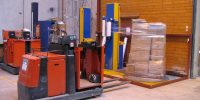Everything That You Need to Know Basic DIY Home Installation Tools
When you live around the city, there is a big chance that your house is filled with different kinds of modern appliances such as a wall-mounted flat screen television, air-condition unit, laundry washers, refrigerator cabinet, wireless doorbells, CCTVs, audio systems, etc. However, there seems to be a misconception about the correct tools to be used, particularly when doing installation versus the house repair tools.
In most occasions, we hire someone to install the equipment and appliances because we are not sure if we are using the right tools to do it. At the same time, I can almost assure you that these tasks are doable even without an expert’s aid. You can do all the installation works yourself provided that you have a general knowledge about equipment installations and maintenance.
That is why we will help you go through the essential DIY (do it yourself) home installation tools, so that you can save money paying for extra installation services.
Hand drill and Drill bits
A hand drill is a tool generally used for making circular holes or moving fasteners. It is equipped with some bit, and secured by a chuck, depending on the application. Whether corded or cordless (chargeable or battery-powered), this is the primary instrument used to fasten or attach the appliances to the wall or panel.
It also comes with adjustable bit-holder ideal for the sizes and shapes of all bits which could produce various types of holes in different materials.
Torpedo level
This tool is a must-have DIY tool that will help you with a perfectly horizontal or vertical level or plumb during the installation process. It ensures equipment in both angles, horizontal or vertical, is equally balanced. And so, when it’s balance it looks fine.
The proper positioning of the appliances results in the motor mechanism functioning properly.
Screwdriver set and Nut drivers
The screwdriver sets are the most common instruments used by professionals and DIY enthusiasts. Screwdrivers are lightweight devices that can be used to fasten and unfasten the fasteners or screws. Screwdrivers rely on the physical strength of the operator when turning clockwise or anti-clockwise, to provide precision power.
A simple tool as it is, either a flatted / slotted type or a Phillips screw or a hex screw, these are devices that are used to ensure the mounted equipment is safe. For better results, make sure the size of the screw to be used matches properly to the drilled holes. Using much larger bolts and nuts for heavier devices, enough to take a firm hold of your unit.
Yet lightweight drivers can be used for portable vehicles like the doorbells and the CCTVs.
Jigsaw cutter
When necessary, you can consider getting a jigsaw cutter too. The jigsaw cutter may be used to make either straight or angled cuts in a universal range of materials, including concrete, hard plywood, drywall, plastic, metal, and ceramic tiles. It is an easy tool to use, which is why most DIYers have it in toolbox.
When you need a strong support when installing the heavier appliances such as the large washing machine or air-condition unit, you would want to level these appliances with wooden or steel frame. The frame serves as the additional protection to your unit to avoid unintended harm due to near contact with the part of the house.
And, of course, you need a jigsaw cutter along with the basic home tools that we already have to form the frame into the desired shape that matches the nature of the household unit. If you want to learn more then click here.
Measuring tool
There are different types of measuring devices available today, from a simple to a digital design measuring tool. Namely: square, tape measure, ruler, angle gauge, caliper, etc.
Each of them falls to a specific and different function. A standard tape measure or ruler would do in your case. Tape measurement lets you calculate the exact size and angle of the device and the precise adjustment process to the region to which it is to be connected. It’s a handy and easy to use tool allowing you to easily measure everything in any position.
Additional recommendations:
These are the optional type of tools used in installation and maintenance process. It can be used depending on the type of household appliance to work on.
- Electrical tape for safety wiring jobs
- Multimetes – this tool is used to measure voltage, current, and resistance
- Pliers – we use this for bending and compressing wide range of materials
- Adjustable wrench – use to loosen or tighten a nut or bolt
- Carpentry knife – ideal for working with wood
- Worker’s protective equipment – the basic examples are working gloves, clear goggles, hard hats, and similar equipment.
When you are still hesitant to the task, there are free tutorials made available in Google and YouTube, and all you have to do is to search in the right key words, for example, “How to install” and the device that you are trying to install.
Always keep in mind that safety precautions should be the top priority when doing DIY projects. And you can always enjoy the process.




